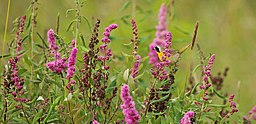 |
Steeple-bush | Status LU: established. 1st record: LU 1847, ITW 1954. |
 |
Douglas-Kluddertrausch | Status Eur.: established. 1st record: ? |
 |
Spirée de Douglas | RA: ISEIA: B0, Alert List. Harmonia+: 0,10. |
 |
Douglas-Spierstrauch | Wikipedia: |
 |
Douglasspirea | Back to the list of neophytes |
Contents
Report the species
→ Report Spiraea douglasii to the National Museum of Natural History.
Brief description
 Both in its native and invaded range, Spiraea douglasii Hook. grows best on loamy and sandy wet soils. It is tolerant to permanently water-logged soils (peat) and widely fluctuating water tables. It occurs mainly in riparian habitats such as swamps, shrub carrs, marshes and bogs. This pioneer species needs full sunlight for optimal growth, flowering and fruiting, but may survive under tree canopies. Contrary to other North American Spiraea species, Douglas’ spirea may produce fertile seeds under Belgian climatic conditions. They are disseminated at a slow rate by wind in the vicinity of parent shrubs and germinate in areas free of dense plant cover. This shrub has been increasingly observed in the wild in Belgium during the last decade.
Both in its native and invaded range, Spiraea douglasii Hook. grows best on loamy and sandy wet soils. It is tolerant to permanently water-logged soils (peat) and widely fluctuating water tables. It occurs mainly in riparian habitats such as swamps, shrub carrs, marshes and bogs. This pioneer species needs full sunlight for optimal growth, flowering and fruiting, but may survive under tree canopies. Contrary to other North American Spiraea species, Douglas’ spirea may produce fertile seeds under Belgian climatic conditions. They are disseminated at a slow rate by wind in the vicinity of parent shrubs and germinate in areas free of dense plant cover. This shrub has been increasingly observed in the wild in Belgium during the last decade.
Douglas’ spirea is a fast-growing rhizomatous shrub, propagating clonally. It easily forms dense monospecific thickets that can colonise large areas, displace other plant species and dominate communities in wetland areas (probably via allelopathic interactions). It can be invasive in its native range and rapidly colonise clearcut areas. It has been reported to be a serious danger to native plant communities in Belgium. Old dry plant shoots are vulnerable to early ignition and may be the cause of fires (Branquart et al. 2010).
Status and distribution in Luxembourg
Records of Spiraea douglasii Hook. in Luxembourg. Data source: Recorder-Lux, iNaturalist & GBIF, 2025-12-06.
Koltz (1875: 67): Native to California, Spiraea douglasii Hook. was introduced in 1847 (jardin des Dominicains). Requires a sheltered spot in fertile soil. Several hardier hybrids are grown which are:
- Spiraea douglasi × callosa (Spiraea nobleana Hook.): Introduced in 1863; jardin des Dominicains.
- Spiraea × pachystachys Hayne.: Introduced 1871; Sandweiler nurseries.
- Spiraea paniculata Bill.: Introduced in 1847; jardin des Dominicains.
Marcel Etringer first documented Spiraea douglasii var. menziesii (under the name Spiraea salicifolia L.) in the wild on 1954-06-29 in a slag heap in Steinfort (Herb. LUX specimen № 50664; MNHNL 2000-).
The earliest herbarium specimen at the MNHNL was collected by Jos Witry in July 1935 in Rumelange (Specimen № 52329, MNHNL 2000-).
This species originates from western North America and is sometimes grown for ornamental purposes in parks. Subspontaneous or naturalised: old hedges, roadsides, groves, slopes (Lambinon & Verloove 2012: 326).
Risk assessment
ISEIA protocol
B0 (2+2+3+2) = Alert List (Ries et al. 2013: 19).
Harmonia+ protocol
Overall risk score 0,10 = (Overall Invasion score 0,18 x Overall Impact score 0,47) (Ries et al. 2020).
 Invasion
Invasion0,47

 Impact
Impact0,10

 Risk
RiskWorldwide distribution
Bibliography
- Branquart, E., S. Vanderhoeven, W. Van Landuyt, F. Van Rossum, F. Verloove & A. Vervoort, 2010. Harmonia database: Spiraea douglasii Hook. Harmonia version 1.2, Belgian Forum on Invasive Species. URL: http://ias.biodiversity.be [accessed on 2019-10-15]
- GBIF, 2020. Spiraea douglasii Hook. in GBIF Secretariat (2019). GBIF Backbone Taxonomy. Checklist dataset https://doi.org/10.15468/39omei [accessed 2020-03-04]
- Lambinon J. & F. Verloove, 2012. Nouvelle flore de la Belgique, du grand-duché de Luxembourg, du Nord de la France et des régions voisines. Sixième édition. Avec la collaboration de L. Delvosalle, B. Toussaint, D. Geerinck, I. Hoste, F. Van Rossum, B. Cornier, R. Schumacker, A. Vanderpoorten et H. Vannerom. Jardin botanique national de Belgique, Meise. CXXXIX + 1195 pp. ISBN : 9789072619884.
- MNHNL, 2000-. Spiraea douglasii Hook. in Recorder-Lux, database on the natural heritage of the Grand Duchy of Luxembourg. Musée national d’histoire naturelle, Luxembourg. URL: https://mdata.mnhn.lu [Accessed 2021-03-12]
- MNHNL, iNaturalist & GBIF, 2019. Spiraea douglasii Hook. in MNHNL-mdata, online portal combining species observation from Recorder-Lux, iNaturalist and GBIF. National Museum of Natural History, Luxembourg. URL: https://mdata.mnhn.lu [Accessed 2019-10-15]
- Ries, C. & Y. Krippel, 2021. First records of 56 invasive alien vascular plants in Luxembourg. Bulletin de la Société des naturalistes luxembourgeois 123: 115-127. [PDF 241 KB]
- Ries, C., Y. Krippel & M. Pfeiffenschneider, 2020. Risk assessment after the Harmonia+ protocol of invasive alien vascular plant species in Luxembourg. Bull. Soc. Nat. luxemb. 122: 197-205. [PDF 132 KB]
- Ries, C., Y. Krippel, M. Pfeiffenschneider & S. Schneider, 2013. Environmental impact assessment and black, watch and alert list classification after the ISEIA Protocol of non-native vascular plant species in Luxembourg. Bull. Soc. Nat. luxemb. 114: 15-21. [PDF 652 KB]
Suggested citation of this webpage
Ries, C., M. Pfeiffenschneider & Y. Krippel (Eds.), 2025. Spiraea douglasii Hook. In: neobiota.lu - Invasive Alien Species in Luxembourg. National Museum of Natural History, Luxembourg. URL: https://neobiota.lu/spiraea-douglasii/ [Accessed 2025-12-06].
Page content last updated on 2021-03-12. Last proofread by Caroline Grounds on 2019-11-21.


